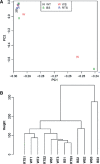Altered gene expression in the Werner and Bloom syndromes is associated with sequences having G-quadruplex forming potential
- PMID: 19966276
- PMCID: PMC2831322
- DOI: 10.1093/nar/gkp1103
Altered gene expression in the Werner and Bloom syndromes is associated with sequences having G-quadruplex forming potential
Abstract
The human Werner and Bloom syndromes (WS and BS) are caused by deficiencies in the WRN and BLM RecQ helicases, respectively. WRN, BLM and their Saccharomyces cerevisiae homologue Sgs1, are particularly active in vitro in unwinding G-quadruplex DNA (G4-DNA), a family of non-canonical nucleic acid structures formed by certain G-rich sequences. Recently, mRNA levels from loci containing potential G-quadruplex-forming sequences (PQS) were found to be preferentially altered in sgs1Delta mutants, suggesting that G4-DNA targeting by Sgs1 directly affects gene expression. Here, we extend these findings to human cells. Using microarrays to measure mRNAs obtained from human fibroblasts deficient for various RecQ family helicases, we observe significant associations between loci that are upregulated in WS or BS cells and loci that have PQS. No such PQS associations were observed for control expression datasets, however. Furthermore, upregulated genes in WS and BS showed no or dramatically reduced associations with sequences similar to PQS but that have considerably reduced potential to form intramolecular G4-DNA. These findings indicate that, like Sgs1, WRN and BLM can regulate transcription globally by targeting G4-DNA.
Figures



Similar articles
-
Relationships between putative G-quadruplex-forming sequences, RecQ helicases, and transcription.BMC Med Genet. 2015 Oct 8;16:91. doi: 10.1186/s12881-015-0236-4. BMC Med Genet. 2015. PMID: 26449372 Free PMC article.
-
Competition between the DNA unwinding and strand pairing activities of the Werner and Bloom syndrome proteins.BMC Mol Biol. 2006 Jan 13;7:1. doi: 10.1186/1471-2199-7-1. BMC Mol Biol. 2006. PMID: 16412221 Free PMC article.
-
The Werner syndrome RECQ helicase targets G4 DNA in human cells to modulate transcription.Hum Mol Genet. 2016 May 15;25(10):2060-2069. doi: 10.1093/hmg/ddw079. Epub 2016 Mar 16. Hum Mol Genet. 2016. PMID: 26984941 Free PMC article.
-
[Functional analysis of yeast homologue gene associated with human DNA helicase causative syndromes].Kokuritsu Iyakuhin Shokuhin Eisei Kenkyusho Hokoku. 2002;(120):53-74. Kokuritsu Iyakuhin Shokuhin Eisei Kenkyusho Hokoku. 2002. PMID: 12638184 Review. Japanese.
-
Functions of RecQ family helicases: possible involvement of Bloom's and Werner's syndrome gene products in guarding genome integrity during DNA replication.J Biochem. 2001 Apr;129(4):501-7. doi: 10.1093/oxfordjournals.jbchem.a002883. J Biochem. 2001. PMID: 11275547 Review.
Cited by
-
The genome-wide distribution of non-B DNA motifs is shaped by operon structure and suggests the transcriptional importance of non-B DNA structures in Escherichia coli.Nucleic Acids Res. 2013 Jul;41(12):5965-77. doi: 10.1093/nar/gkt308. Epub 2013 Apr 25. Nucleic Acids Res. 2013. PMID: 23620297 Free PMC article.
-
Human RecQ Helicases in DNA Double-Strand Break Repair.Front Cell Dev Biol. 2021 Feb 25;9:640755. doi: 10.3389/fcell.2021.640755. eCollection 2021. Front Cell Dev Biol. 2021. PMID: 33718381 Free PMC article. Review.
-
Cation competition and recruitment around the c-kit1 G-quadruplex using polarizable simulations.Biophys J. 2021 Jun 1;120(11):2249-2261. doi: 10.1016/j.bpj.2021.03.022. Epub 2021 Mar 29. Biophys J. 2021. PMID: 33794153 Free PMC article.
-
Response to Replication Stress and Maintenance of Genome Stability by WRN, the Werner Syndrome Protein.Int J Mol Sci. 2024 Jul 30;25(15):8300. doi: 10.3390/ijms25158300. Int J Mol Sci. 2024. PMID: 39125869 Free PMC article. Review.
-
Evidence That G-quadruplex DNA Accumulates in the Cytoplasm and Participates in Stress Granule Assembly in Response to Oxidative Stress.J Biol Chem. 2016 Aug 19;291(34):18041-57. doi: 10.1074/jbc.M116.718478. Epub 2016 Jul 1. J Biol Chem. 2016. PMID: 27369081 Free PMC article.
References
Publication types
MeSH terms
Substances
Grants and funding
LinkOut - more resources
Full Text Sources
Molecular Biology Databases
Research Materials

